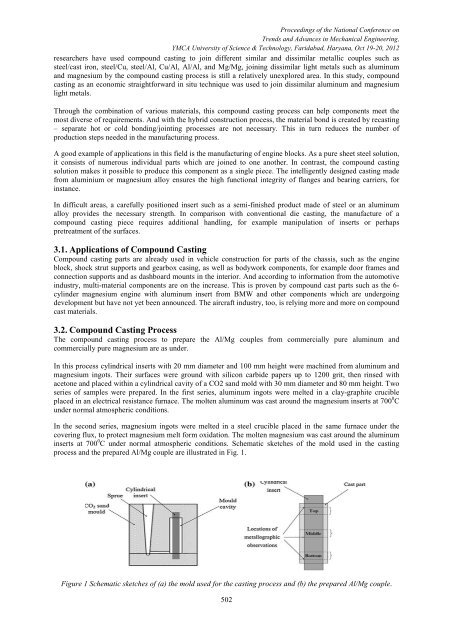compound casting - a literature review - YMCA University of Science ...
compound casting - a literature review - YMCA University of Science ...
compound casting - a literature review - YMCA University of Science ...
Create successful ePaper yourself
Turn your PDF publications into a flip-book with our unique Google optimized e-Paper software.
Proceedings <strong>of</strong> the National Conference onTrends and Advances in Mechanical Engineering,<strong>YMCA</strong> <strong>University</strong> <strong>of</strong> <strong>Science</strong> & Technology, Faridabad, Haryana, Oct 19-20, 2012researchers have used <strong>compound</strong> <strong>casting</strong> to join different similar and dissimilar metallic couples such assteel/cast iron, steel/Cu, steel/Al, Cu/Al, Al/Al, and Mg/Mg, joining dissimilar light metals such as aluminumand magnesium by the <strong>compound</strong> <strong>casting</strong> process is still a relatively unexplored area. In this study, <strong>compound</strong><strong>casting</strong> as an economic straightforward in situ technique was used to join dissimilar aluminum and magnesiumlight metals.Through the combination <strong>of</strong> various materials, this <strong>compound</strong> <strong>casting</strong> process can help components meet themost diverse <strong>of</strong> requirements. And with the hybrid construction process, the material bond is created by re<strong>casting</strong>– separate hot or cold bonding/jointing processes are not necessary. This in turn reduces the number <strong>of</strong>production steps needed in the manufacturing process.A good example <strong>of</strong> applications in this field is the manufacturing <strong>of</strong> engine blocks. As a pure sheet steel solution,it consists <strong>of</strong> numerous individual parts which are joined to one another. In contrast, the <strong>compound</strong> <strong>casting</strong>solution makes it possible to produce this component as a single piece. The intelligently designed <strong>casting</strong> madefrom aluminium or magnesium alloy ensures the high functional integrity <strong>of</strong> flanges and bearing carriers, forinstance.In difficult areas, a carefully positioned insert such as a semi-finished product made <strong>of</strong> steel or an aluminumalloy provides the necessary strength. In comparison with conventional die <strong>casting</strong>, the manufacture <strong>of</strong> a<strong>compound</strong> <strong>casting</strong> piece requires additional handling, for example manipulation <strong>of</strong> inserts or perhapspretreatment <strong>of</strong> the surfaces.3.1. Applications <strong>of</strong> Compound CastingCompound <strong>casting</strong> parts are already used in vehicle construction for parts <strong>of</strong> the chassis, such as the engineblock, shock strut supports and gearbox casing, as well as bodywork components, for example door frames andconnection supports and as dashboard mounts in the interior. And according to information from the automotiveindustry, multi-material components are on the increase. This is proven by <strong>compound</strong> cast parts such as the 6-cylinder magnesium engine with aluminum insert from BMW and other components which are undergoingdevelopment but have not yet been announced. The aircraft industry, too, is relying more and more on <strong>compound</strong>cast materials.3.2. Compound Casting ProcessThe <strong>compound</strong> <strong>casting</strong> process to prepare the Al/Mg couples from commercially pure aluminum andcommercially pure magnesium are as under.In this process cylindrical inserts with 20 mm diameter and 100 mm height were machined from aluminum andmagnesium ingots. Their surfaces were ground with silicon carbide papers up to 1200 grit, then rinsed withacetone and placed within a cylindrical cavity <strong>of</strong> a CO2 sand mold with 30 mm diameter and 80 mm height. Twoseries <strong>of</strong> samples were prepared. In the first series, aluminum ingots were melted in a clay-graphite crucibleplaced in an electrical resistance furnace. The molten aluminum was cast around the magnesium inserts at 700 0 Cunder normal atmospheric conditions.In the second series, magnesium ingots were melted in a steel crucible placed in the same furnace under thecovering flux, to protect magnesium melt form oxidation. The molten magnesium was cast around the aluminuminserts at 7000 C under normal atmospheric conditions. Schematic sketches <strong>of</strong> the mold used in the <strong>casting</strong>process and the prepared Al/Mg couple are illustrated in Fig. 1.Figure 1 Schematic sketches <strong>of</strong> (a) the mold used for the <strong>casting</strong> process and (b) the prepared Al/Mg couple.502













